Ajmer
Dargah Shariff
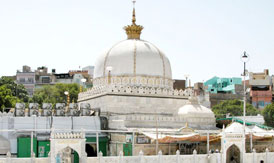 Ajmer is situated at the foot of an 800-feet high mountain on the top of which stands, in solemn splendour, the celebrated fort of Garh Beetli or Bithali named after Bithaldas Gaur the trusted General of Emperor Shah Jahan, which is now called Taragarh (the star citadel). This city stretches out in all directions of a spacious valley and is hemmed in on all sides by picturesque hills. Its holy traditions are equally replete with Rajput chivalry and Muslim supremacy in the past history of Hindustan. Few cities of India can boast of Ajmer’s religious sanctity for both Hindus and Muslims, its glorious history and it natural beauty. It was in Ajmer that Khawaja Muinuddin Chishti laid the permanent foundation of Islam in India in 1192 A.D. by his spiritual powers and peaceful preachings. It was in Ajmer that Sir Thomas Roe, as ambassador of King James I of England, had his audience with Emperor Jahangir on 19th January 1616 A.D. which laid the steping stone of the British Raj in India through the charter of free trading granted to the East India Company by the Emperor.
Ajmer is situated at the foot of an 800-feet high mountain on the top of which stands, in solemn splendour, the celebrated fort of Garh Beetli or Bithali named after Bithaldas Gaur the trusted General of Emperor Shah Jahan, which is now called Taragarh (the star citadel). This city stretches out in all directions of a spacious valley and is hemmed in on all sides by picturesque hills. Its holy traditions are equally replete with Rajput chivalry and Muslim supremacy in the past history of Hindustan. Few cities of India can boast of Ajmer’s religious sanctity for both Hindus and Muslims, its glorious history and it natural beauty. It was in Ajmer that Khawaja Muinuddin Chishti laid the permanent foundation of Islam in India in 1192 A.D. by his spiritual powers and peaceful preachings. It was in Ajmer that Sir Thomas Roe, as ambassador of King James I of England, had his audience with Emperor Jahangir on 19th January 1616 A.D. which laid the steping stone of the British Raj in India through the charter of free trading granted to the East India Company by the Emperor.
Nasiyan Jain Temple
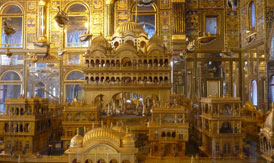 The renowned Nasiyan Jain Temple is to be found at Prithviraj Marg in Ajmer, Rajasthan. After the temples of Ranakpur and Mount Abu, Nasiyan temple is regarded as one of the best Jain temples in Rajasthan. Built in 1865, Nasiyan Temple is also known as Lal Mandir (Red Temple). Centrally located in Ajmer, the temple can be reached easily from anywhere in Rajasthan. Nasiyan Digambar Jain Temple is dedicated to Lord Adinath, the first Jain 'tirthankara'. The two-storied structure of Nasiyan Temple is divided into two parts, where one is the worship area comprising the idol of Lord Adinath and the second is the museum including a hall. The museum hall gets the major attention due to its mind blowing interiors made up in gold. This exquisite museum depicts the five stages (Panch Kalyanak) in the life of Lord Adinath, in the stature of statues. With the dimensions of 40 x 80 feet, the hall is adorned with Belgium stain glass, mineral color paintings and stain glasswork.
The renowned Nasiyan Jain Temple is to be found at Prithviraj Marg in Ajmer, Rajasthan. After the temples of Ranakpur and Mount Abu, Nasiyan temple is regarded as one of the best Jain temples in Rajasthan. Built in 1865, Nasiyan Temple is also known as Lal Mandir (Red Temple). Centrally located in Ajmer, the temple can be reached easily from anywhere in Rajasthan. Nasiyan Digambar Jain Temple is dedicated to Lord Adinath, the first Jain 'tirthankara'. The two-storied structure of Nasiyan Temple is divided into two parts, where one is the worship area comprising the idol of Lord Adinath and the second is the museum including a hall. The museum hall gets the major attention due to its mind blowing interiors made up in gold. This exquisite museum depicts the five stages (Panch Kalyanak) in the life of Lord Adinath, in the stature of statues. With the dimensions of 40 x 80 feet, the hall is adorned with Belgium stain glass, mineral color paintings and stain glasswork.
Ana Sagar Lake
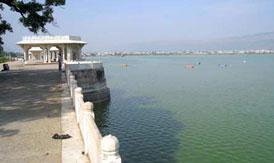 The picturesque Ana Sagar Lake in Ajmer was established by emperor “Anaji Chauhan”, who is the grandfather of “Prithvi Raj Chauhan”. Hence, the lake is named after the sovereign Anaji chauhan. King Anaji Chauhan built this lake at some stage between 1135 -1150 AD. He built this lake for the betterment of the civilization. Basically, AnaSagar Lake was constructed by raising a dam across the “Luni or Lavanavari River”. The catchments of the lake were constructed with the huge support and assistance of the community. The arresting Pavilions or “Baradari” that are nearby the lake were constructed in 1637 by the Mughal emperor Shahjahan. The Baradari is essentially a Marble stone pavilion. The “Daulat Bagh Gardens” that surrounds the Ana Saga Lake were established by Mughal sovereign Jehangir. The circuit residence that’s placed on the hilltop in the vicinity of Ana Sagar Lake once served as the British Residency. The High court has prohibited the edifice in the catchment regions of the Ana Sagar Lake areas in order to maintain the charismatic splendor of the lake.
The picturesque Ana Sagar Lake in Ajmer was established by emperor “Anaji Chauhan”, who is the grandfather of “Prithvi Raj Chauhan”. Hence, the lake is named after the sovereign Anaji chauhan. King Anaji Chauhan built this lake at some stage between 1135 -1150 AD. He built this lake for the betterment of the civilization. Basically, AnaSagar Lake was constructed by raising a dam across the “Luni or Lavanavari River”. The catchments of the lake were constructed with the huge support and assistance of the community. The arresting Pavilions or “Baradari” that are nearby the lake were constructed in 1637 by the Mughal emperor Shahjahan. The Baradari is essentially a Marble stone pavilion. The “Daulat Bagh Gardens” that surrounds the Ana Saga Lake were established by Mughal sovereign Jehangir. The circuit residence that’s placed on the hilltop in the vicinity of Ana Sagar Lake once served as the British Residency. The High court has prohibited the edifice in the catchment regions of the Ana Sagar Lake areas in order to maintain the charismatic splendor of the lake.
Adhai-din ka Jhonpra Mosque
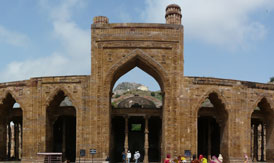 Adhai-din-ka-Jhonpra is one of the classic instances of religious vandalism, an outstanding example of an edifice built over the ruins of Jain temples. This famous mosque, situated on the border of Ajmer, is an inimitable example of primitive Indo-Islamic architecture. Constructed by Muhammad Ghori, Adhai- din-ka-Jhonpra has a slew of interesting legends to its name. While some believe that this mosque was built within a short span of two and half days and hence, the name, a few others associate the name to the two and half day fair that is held within the mosque premise every year. Previously, a seat of learning, this place was seized, demolished, and restored as a mosque by Ghori in the year 1198. Ghori constructed seven arched walls around the mosque and engraved it with calligraphic verses from the Holy Quran. Later, an attractive tower was added to the place. Today, this striking piece of architecture stands tall with its towering domes, pillars, and arched screens.
Adhai-din-ka-Jhonpra is one of the classic instances of religious vandalism, an outstanding example of an edifice built over the ruins of Jain temples. This famous mosque, situated on the border of Ajmer, is an inimitable example of primitive Indo-Islamic architecture. Constructed by Muhammad Ghori, Adhai- din-ka-Jhonpra has a slew of interesting legends to its name. While some believe that this mosque was built within a short span of two and half days and hence, the name, a few others associate the name to the two and half day fair that is held within the mosque premise every year. Previously, a seat of learning, this place was seized, demolished, and restored as a mosque by Ghori in the year 1198. Ghori constructed seven arched walls around the mosque and engraved it with calligraphic verses from the Holy Quran. Later, an attractive tower was added to the place. Today, this striking piece of architecture stands tall with its towering domes, pillars, and arched screens.
Nareli Jain Temple
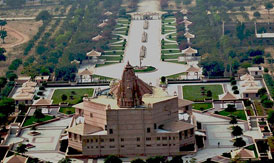 Nareli is a famous Jain Temple. The Temple is a mixing of traditional and contemporary architectural styles, with 24 further miniature temples lined up on the hill above.These 24 temples represent the Thirthankar's of Jain's also called as 24 Jainalay.
The place became an important site of pilgrimage of Digambara Jains. This Jain temple is famous for its carvings and intricate designs.
Shri Gyandoaya Tirth Kshetra is the other name for this Jain Temple. There is a lot more temples and shrines inside this Kshetra. Some of them are under construction. Acharya Shri Vidya Sagar's disciple Jain Sage, Muni Sudha Sagar blessed the construction of the tirth and the building work started on 1994-95. In the year 2002 the largest ever-made statues of Ashta-dhatu (an alloy of eight metals) are being installed at the temple complex
Nareli is a famous Jain Temple. The Temple is a mixing of traditional and contemporary architectural styles, with 24 further miniature temples lined up on the hill above.These 24 temples represent the Thirthankar's of Jain's also called as 24 Jainalay.
The place became an important site of pilgrimage of Digambara Jains. This Jain temple is famous for its carvings and intricate designs.
Shri Gyandoaya Tirth Kshetra is the other name for this Jain Temple. There is a lot more temples and shrines inside this Kshetra. Some of them are under construction. Acharya Shri Vidya Sagar's disciple Jain Sage, Muni Sudha Sagar blessed the construction of the tirth and the building work started on 1994-95. In the year 2002 the largest ever-made statues of Ashta-dhatu (an alloy of eight metals) are being installed at the temple complex
Akbar's Palace & Museum
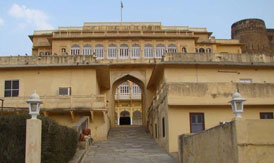 Akbar’s palace and museum is considered to be the home of the Mughal emperor, Akbar, at one point in time. This was later converted to a government museum. As you visit this glorious palace one can see the fort of the erstwhile Mughal emperor and see some fantastic sculptures which were originally brought from the cities of Sirohi, Pushkar, Bharatpur, Osian, Harsnath which is now known as Sikar, Pisangan and Baghera. There are a huge number of Forts and Palaces in Ajmer, which are Akbar Fort, Taragarh Fort, Mansingh Palace, Bijay Niwas Palace and much more. But among all these forts and palaces one of the most famous palace is Akbar's Palace. Akbar's Palace, Ajmer is one of the most beautiful monuments in the city and shows the brilliant work of art and skill that has been used to construct this palace.
Akbar’s palace and museum is considered to be the home of the Mughal emperor, Akbar, at one point in time. This was later converted to a government museum. As you visit this glorious palace one can see the fort of the erstwhile Mughal emperor and see some fantastic sculptures which were originally brought from the cities of Sirohi, Pushkar, Bharatpur, Osian, Harsnath which is now known as Sikar, Pisangan and Baghera. There are a huge number of Forts and Palaces in Ajmer, which are Akbar Fort, Taragarh Fort, Mansingh Palace, Bijay Niwas Palace and much more. But among all these forts and palaces one of the most famous palace is Akbar's Palace. Akbar's Palace, Ajmer is one of the most beautiful monuments in the city and shows the brilliant work of art and skill that has been used to construct this palace.
Birla City Water Park
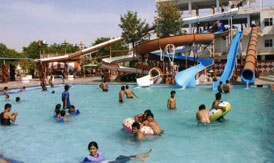 Birla City Water Park is located at just 5 kms away from Railway Station , 7 kms from Bus Station , Ajmer, Rajasthan, India of Makhupura Road. Spread in 6 Acres of land amidst greenery with fully grown shaded trees, the Birla City Water Water Park provides a pleasant and soothing feel. With its most economical rates Birla City Water Park has AC Dormitories and Cottages and is ideal for School Picnic / Camping / Private Parties / Get-Together Celebrations /Wedding Anniversaries / Kitty Parties etc. Birla City Water Park provides both One Day Picnic and Over Night Stay. Birla City WaterPark has a Big Swimming Pool, Water Park with 7 Slides, Water Fall and Rain Dance along with play park for kids with Mini Train, Jumbo Ride, Mini Space Shuttle, Frog, Merry-Go-Round in pool, Indoor-Outdoor games. Besides this Birla City Water Park has its own Conference Room, Rooms and Dormitory Accommodation with Good Quality Food.
Birla City Water Park is located at just 5 kms away from Railway Station , 7 kms from Bus Station , Ajmer, Rajasthan, India of Makhupura Road. Spread in 6 Acres of land amidst greenery with fully grown shaded trees, the Birla City Water Water Park provides a pleasant and soothing feel. With its most economical rates Birla City Water Park has AC Dormitories and Cottages and is ideal for School Picnic / Camping / Private Parties / Get-Together Celebrations /Wedding Anniversaries / Kitty Parties etc. Birla City Water Park provides both One Day Picnic and Over Night Stay. Birla City WaterPark has a Big Swimming Pool, Water Park with 7 Slides, Water Fall and Rain Dance along with play park for kids with Mini Train, Jumbo Ride, Mini Space Shuttle, Frog, Merry-Go-Round in pool, Indoor-Outdoor games. Besides this Birla City Water Park has its own Conference Room, Rooms and Dormitory Accommodation with Good Quality Food.
Shah Jahan's Mosque
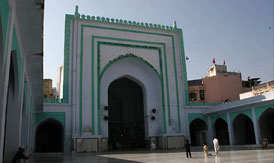 Shah Jahan's Mosque is housed within the inner courtyards of the Dargah Sharif. Made of white marble, the edifice has a 30.5 metres long and narrow court having a low arcade. The sanctum has delicate carvings with trellis works. Featuring 11 arches, the mosque has been constructed in typical Mughal architectural style. Having a height of 41 metres, the mosque is topped by a beautiful marble dome. It is believed that the marble for building the dome was extracted from the same mines from where marble for Taj Mahal was extracted. Built by the Mughal Emperor Shah Jahan, the mosque is green and white coloured. The Shah Jahan’s Mosque is built within the inner courtyards of the Dargah Sharif in Ajmer, Rajasthan. This monument is another example of the grandeur of the Mughal Sultanate. The monument was built by Emperor Shah Jahan and it still stands strong here. Located just beside the shrine of Sheikh Salim Chisti, this was always a very important place for the Mughal Rulers as they were the followers of the great saint.
Shah Jahan's Mosque is housed within the inner courtyards of the Dargah Sharif. Made of white marble, the edifice has a 30.5 metres long and narrow court having a low arcade. The sanctum has delicate carvings with trellis works. Featuring 11 arches, the mosque has been constructed in typical Mughal architectural style. Having a height of 41 metres, the mosque is topped by a beautiful marble dome. It is believed that the marble for building the dome was extracted from the same mines from where marble for Taj Mahal was extracted. Built by the Mughal Emperor Shah Jahan, the mosque is green and white coloured. The Shah Jahan’s Mosque is built within the inner courtyards of the Dargah Sharif in Ajmer, Rajasthan. This monument is another example of the grandeur of the Mughal Sultanate. The monument was built by Emperor Shah Jahan and it still stands strong here. Located just beside the shrine of Sheikh Salim Chisti, this was always a very important place for the Mughal Rulers as they were the followers of the great saint.
St. Mary's Graveyard
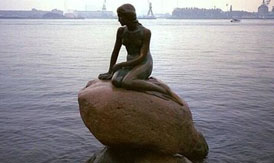 St Mary's Church graveyard is located right next to the Nasirabad railway station.
St Mary's Church graveyard has numerous graves laid inside the premises. The tombs are a mix of Gothic and Indo-Saracenic style with marble plaques raised on a few of them. The graves are well kept and arranged around pavilions inside the cemetery. The St Mary's Church Graveyard is often visited by a lot of people who have their loved ones buried here. Many of the tombs belong to the British officers of the East Indian Company and their families. One can also visit the St. Mary's Church, an Anglican Church, while visiting the graveyard. This beautiful church was built more than a century ago and it has the records to many of the tombs found in the graveyard. It also has a part of the original piece of wood on which Jesus Christ was crucified. As the weather can be very hot during the summers, the best time to visit St Mary's Church graveyard is in the months of October and February when the weather is pleasant. Reaching St Mary's Church graveyard is easy as there are many buses, trains and cabs that connect it.
St Mary's Church graveyard is located right next to the Nasirabad railway station.
St Mary's Church graveyard has numerous graves laid inside the premises. The tombs are a mix of Gothic and Indo-Saracenic style with marble plaques raised on a few of them. The graves are well kept and arranged around pavilions inside the cemetery. The St Mary's Church Graveyard is often visited by a lot of people who have their loved ones buried here. Many of the tombs belong to the British officers of the East Indian Company and their families. One can also visit the St. Mary's Church, an Anglican Church, while visiting the graveyard. This beautiful church was built more than a century ago and it has the records to many of the tombs found in the graveyard. It also has a part of the original piece of wood on which Jesus Christ was crucified. As the weather can be very hot during the summers, the best time to visit St Mary's Church graveyard is in the months of October and February when the weather is pleasant. Reaching St Mary's Church graveyard is easy as there are many buses, trains and cabs that connect it.